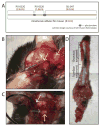Novel intrathecal and subcutaneous catheter delivery systems in the mouse
- PMID: 26976722
- PMCID: PMC5014366
- DOI: 10.1016/j.jneumeth.2016.03.006
Novel intrathecal and subcutaneous catheter delivery systems in the mouse
Abstract
Background: Catheter systems that permit targeted delivery of genes, molecules, ligands, and other agents represent an investigative tool critical to the development of clinically relevant animal models that facilitate the study of neurological health and disease. The development of new sustained catheter delivery systems to spinal and peripheral sites will reduce the need for repeated injections, while ensuring constant levels of drug in plasma and tissues.
New method: Here, we introduce two novel catheter delivery systems in the mouse: the O'Buckley intrathecal catheter system for sustained delivery to the spinal region and a subcutaneous bifurcated catheter system for sustained drug delivery to both hindpaws.
Results: The O'Buckley intrathecal catheter system consistently distributed Evans Blue throughout the spinal cord, with the greatest concentration at the thoracic region, and with an 85% surgery success rate. The subcutaneous catheter system consistently distributed Evans Blue to the hindlimbs, with a 100% surgery success rate.
Comparison to existing method: The O'Buckley intrathecal catheter system accomplishes sustained drug delivery to the spinal region, with a 2-fold increase in surgery success rate, as compared to the traditional method. Our subcutaneous bifurcated catheter system accomplishes sustained drug delivery to both hindpaws, eliminating the need for repeated intraplantar injections.
Conclusions: We have developed catheter systems that improve upon traditional methods in order to achieve sustained localized drug delivery to spinal tissues and to hindpaw tissues surrounding peripheral sciatic nerve terminals. These methods have a broad reach, and can be used to enhance behavioral, physiologic and mechanistic studies in mice.
Keywords: Bifurcated; Continuous infusion; Drug delivery; Hindpaw; Mouse; Osmotic pump; Peripheral; Routes of administration; Spinal cord; Surgical methods.
Copyright © 2016 Elsevier B.V. All rights reserved.
Figures








Similar articles
-
Intrathecal Catheterization and Drug Delivery in Guinea Pigs: A Small-animal Model for Morphine-evoked Granuloma Formation.Anesthesiology. 2016 Aug;125(2):378-94. doi: 10.1097/ALN.0000000000001166. Anesthesiology. 2016. PMID: 27272672
-
Intrathecal drug delivery for pain: a clinical guide and future directions.Pain Manag. 2015;5(3):175-83. doi: 10.2217/pmt.15.12. Pain Manag. 2015. PMID: 25971641
-
Refinement of intrathecal catheter design to enhance neuraxial distribution.J Neurosci Methods. 2024 Feb;402:110006. doi: 10.1016/j.jneumeth.2023.110006. Epub 2023 Nov 13. J Neurosci Methods. 2024. PMID: 37967672
-
Intrathecal pumps.Neurotherapeutics. 2008 Jan;5(1):114-22. doi: 10.1016/j.nurt.2007.10.070. Neurotherapeutics. 2008. PMID: 18164490 Free PMC article. Review.
-
Best practices for intrathecal drug delivery for pain.Neuromodulation. 2014 Jun;17(4):354-72; discussion 372. doi: 10.1111/ner.12146. Epub 2014 Jan 21. Neuromodulation. 2014. PMID: 24446870 Review.
Cited by
-
Neural Stem Cells Overexpressing Nerve Growth Factor Improve Functional Recovery in Rats Following Spinal Cord Injury via Modulating Microenvironment and Enhancing Endogenous Neurogenesis.Front Cell Neurosci. 2021 Dec 2;15:773375. doi: 10.3389/fncel.2021.773375. eCollection 2021. Front Cell Neurosci. 2021. PMID: 34924958 Free PMC article.
-
Epidural and Intrathecal Drug Delivery in Rats and Mice for Experimental Research: Fundamental Concepts, Techniques, Precaution, and Application.Biomedicines. 2023 May 10;11(5):1413. doi: 10.3390/biomedicines11051413. Biomedicines. 2023. PMID: 37239084 Free PMC article. Review.
References
-
- Altaner C, Altanerova V, Cihova M, Ondicova K, Rychly B, Baciak L, et al. Complete regression of glioblastoma by mesenchymal stem cells mediated prodrug gene therapy simulating clinical therapeutic scenario. Int J Cancer. 2014 Mar 15;134(6):1458–65. - PubMed
-
- Anderson JM, McNally AK. Biocompatibility of implants: lymphocyte/macrophage interactions. Semin Immunopathol. 2011 Jan 27;33(3):221–33. - PubMed
-
- Blenkinsopp EC, Blenkisopp WK. Effects of a glucocorticoid (dexamethasone) on the eosinophils of the rat. J Endocrinol. 1967 Apr 1;37(4):463–9. - PubMed
-
- Blenkisopp WK. Comparison of multiple injections with continuous infusion of tritiated thymidine, and estimation of the cell cycle time. J Cell Sci. 1969 Nov;5(3):575–82. - PubMed
Publication types
MeSH terms
Grants and funding
LinkOut - more resources
Full Text Sources
Other Literature Sources

